Published 5 NOV 2024
Julia Scher
Let them know your scarlet heat, let them glisten
1 NOV until 30 NOV 2024
Esther Schipper is pleased to announce Let them know your scarlet heat, let them glisten, a presentation by Julia Scher who has had six solo exhibitions with the gallery. On view will be two important historical works from her iconic Surveillance Beds series, sculptural works integrating technological and surveillance equipment. The title, a quotation from Walt Whitman’s Leaves of Grass in which the poet writes of bloody drops of desire and confession, refers to a central ambivalence in Scher’s work between pleasure, pain, and intimacy.
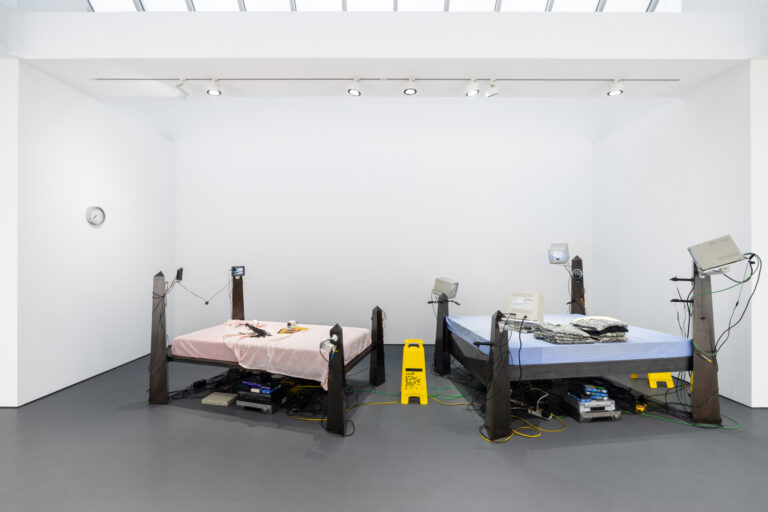
Left:
Julia Scher
Mama Bed, 2003
Bedstead, steel, wood, foam, plastic, 2 monitors, 2 surveillance cameras, VHS player, VHS tapes, cables, bed sheets, books, leather whip
223 x 132,8 cm (floor plan bed) Dimensions variable
Right:
Julia Scher
Papa Bed, 2003
Bedstead, steel, wood, foam, plastic, 4 monitors, 10 surveillance cameras, 2 computer-video-switchers, 2 video recorders, VHS players, VHS tapes, transformer, cables, several bed sheets, US Army apparel, yellow floor sign
223,5 x 170,5 cm (floor plan bed) Dimensions variable
Exhibition view: Julia Scher, Let them know your scarlet heat, let them glisten, Esther Schipper, Berlin 2024
Courtesy the artist and Esther Schipper, Berlin/Paris/Seoul
Photo © Andrea Rossetti
Emerging in the mid 1980s as a precise but playful analyst of social and technological changes, Julia Scher has been working with video surveillance for over 40 years. She addresses surveillance both as a concrete phenomenon of control, including its apparatus and architecture, as well as its impact on private and public spheres. Her performances and installations drew attention to the effects of omnipresent cameras and monitors, anticipating our surveillance-saturated society decades before it had fully arrived.
The artist’s focus on the regulation and control of our private sphere is exemplified by her central works Mama Bed and Papa Bed, 2003. Mama Bed and Papa Bed are two of three installation works (Mama Bed, Papa Bed and Baby Bed) that made up the work Embedded (2003), which debuted in Max Hollein’s era-defining exhibition At Your Own Risk at the Schirn Kunsthalle, Frankfurt. They are also part of the Surveillance Beds series that Julia Scher created between 1994 and 2003. Another work from this series, Surveillance Bed IV, will be shown at Centre Pompidou in early 2025 as part of their collection presentation celebrating the seminal French collector Jean Chatelus, who passed away earlier this year. Each work consists of four steel poles, a flat surface in the middle and various electronic components: cameras, monitors, microphones and cabling. Specific components of Mama Bed include children picture books (namely Goldilocks and the Three Bears) as well as a leather whip, common in BDSM practice, displayed on top of the bed. Specific components of the Papa Bed include uniforms of the US army, folded and placed on the bed. The original constellation of three works vaguely referenced Goldilocks, a fairytale in which three bear protagonists (the bear-father, the bear-mother and the bear-child) find their beds unmade by an unwanted human girl, a metaphor for the violence and trespassing that can occur even in the most intimate spaces.
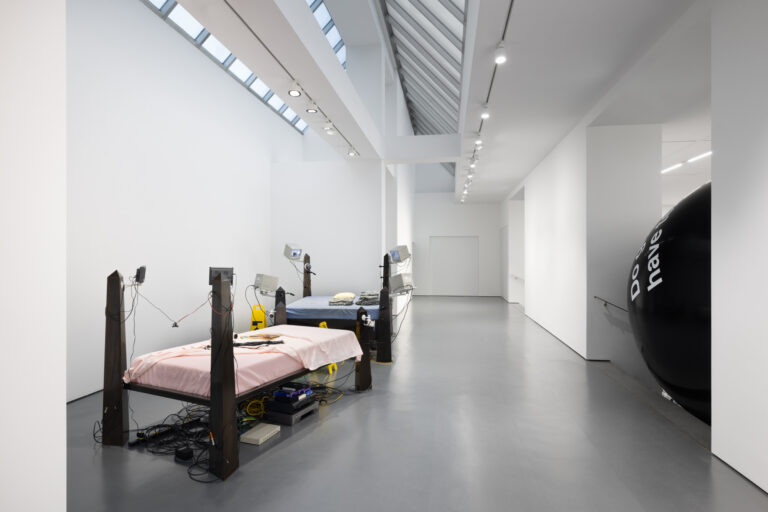
Left:
Julia Scher
Mama Bed, 2003
Bedstead, steel, wood, foam, plastic, 2 monitors, 2 surveillance cameras, VHS player, VHS tapes, cables, bed sheets, books, leather whip
223 x 132,8 cm (floor plan bed) Dimensions variable
Right:
Julia Scher
Papa Bed, 2003
Bedstead, steel, wood, foam, plastic, 4 monitors, 10 surveillance cameras, 2 computer-video-switchers, 2 video recorders, VHS players, VHS tapes, transformer, cables, several bed sheets, US Army apparel, yellow floor sign
223,5 x 170,5 cm (floor plan bed) Dimensions variable
Exhibition view: Julia Scher, Let them know your scarlet heat, let them glisten, Esther Schipper, Berlin 2024
Courtesy the artist and Esther Schipper, Berlin/Paris/Seoul
Photo © Andrea Rossetti
Both works have functioning cameras that record what is happening in the exhibition space and send the live feed to monitors mounted on the steel poles. Mama Bed and Papa Bed have VHS and media players connected to switcher devices that interlace the live feed from the cameras with the pre-recorded ‘fake live footage.’ Some of the cameras and other electronic components are, however, non-functioning, incorporated into the work for the sake of deceit or disguise.
Created in the years directly following the Al-Qaeda attack on the twin towers on September 11, 2001 and in the early years of personal computing and reality television, the pieces speak to the tension between surveillance as a means of protection, exhibitionism, and state violence. While photojournalism during the Vietnam War was enough to incite the American public to protest and push the military to remove its troops, Scher argues that we have since become inured to the violence of war that we see on TV and phone screens. Restaging the piece today serves as a reminder of our contradicting desires and fears: to be safely tucked into bed and be sheltered from the world, to use screens to stage ourselves and reveal intimate moments of our lives, to watch and be surveilled.
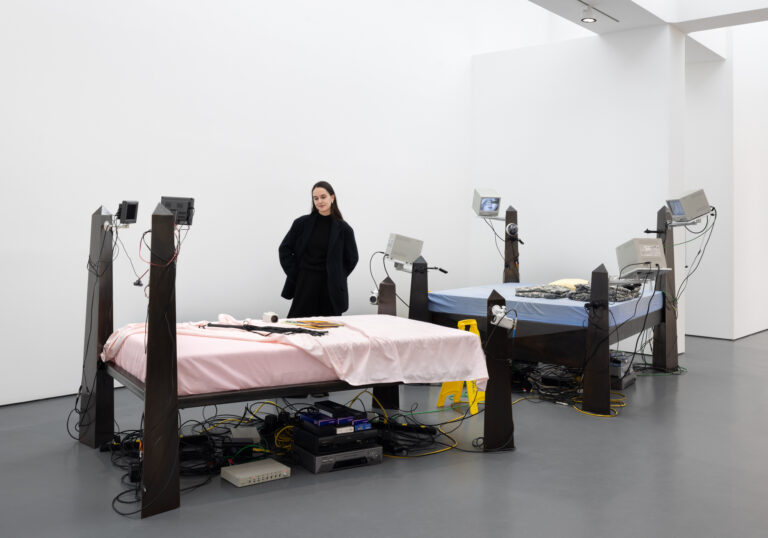
Left:
Julia Scher
Mama Bed, 2003
Bedstead, steel, wood, foam, plastic, 2 monitors, 2 surveillance cameras, VHS player, VHS tapes, cables, bed sheets, books, leather whip
223 x 132,8 cm (floor plan bed) Dimensions variable
Right:
Julia Scher
Papa Bed, 2003
Bedstead, steel, wood, foam, plastic, 4 monitors, 10 surveillance cameras, 2 computer-video-switchers, 2 video recorders, VHS players, VHS tapes, transformer, cables, several bed sheets, US Army apparel, yellow floor sign
223,5 x 170,5 cm (floor plan bed) Dimensions variable
Exhibition view: Julia Scher, Let them know your scarlet heat, let them glisten, Esther Schipper, Berlin 2024
Courtesy the artist and Esther Schipper, Berlin/Paris/Seoul
Photo © Andrea Rossetti
Among her most recent institutional exhibitions are: Maximum Security Society, Museum Abteiberg, Mönchengladbach (2023); Maximum Security Society, Kunsthalle Zürich, Zurich (2022); Wonderland, Maison Populaire, Montreuil (2022); Planet Greyhound, Kunsthalle Gießen (2022); Julia Scher, MAMCO, Geneva (2021); and Julia Scher – Delta, Neuer Aachener Kunstverein, Aachen (2018).
She is the recipient of several grants and fellowships including the Andrew W. Mellon Foundation Preservation Grant for Media Arts, the John F. Simon Guggenheim Memorial Foundation Fellowship for Installation Art (2005), The Bunting Institute Fellowship for Surveillance Studies at Harvard University (1996–1997), and the NEA Grant for Installation Art (1992).
Julia Scher has taught and lectured at numerous institutions including the Massachusetts Institute of Technology, The Cooper Union for Art and Science, Hartford University Art School, the University of California, Los Angeles, the University of Southern California, Harvard University, Columbia University, The Institute for Advanced Study at Princeton, and Rutgers University. While teaching at the Department of Film and Video at the Massachusetts College of Art, (1995–1996), she launched the first “Surveillance Studies” class in the United States. From 2006-2023, Scher was Professor for Multimedia Performance Surveillant Architectures at the Academy of Media Arts in Cologne.
Her work is held in multiple collections: MoMA, New York; Ballroom Marfa, Texas; Kunstsammlungen, Wiesbaden; Walker Art Center, Minneapolis; John Simon Guggenheim Memorial Foundation, New York; Julia Stoschek Collection, Düsseldorf/Berlin; Krannert Art Museum, Champaign, Illinois; Le Consortium, Dijon; Museum Ludwig, Cologne; MAMCO, Geneva; MIT List Visual Arts Center, Cambridge, Massachusetts; Museen Sammlung zeitgenössischer Kunst der Bundesrepublik Deutschland; Centre Pompidou, Paris; MoMA PS1, Long Island City, New York; Neue Galerie Graz – Universalmuseum Joanneum, Graz; Radcliffe Institute, Harvard University, Cambridge, Massachusetts, and SFMOMA, San Francisco.
For press inquiries please contact David Ulrichs. Tel: +49 (0) 176 50 33 01 35 or david@davidulrichs.com
Ryan Gander
THIS IS FEELING ALL OF IT
1 NOV until 7 DEC 2024
Esther Schipper is pleased to announce THIS IS FEELING ALL OF IT, Ryan Gander’s third solo exhibition with the gallery.
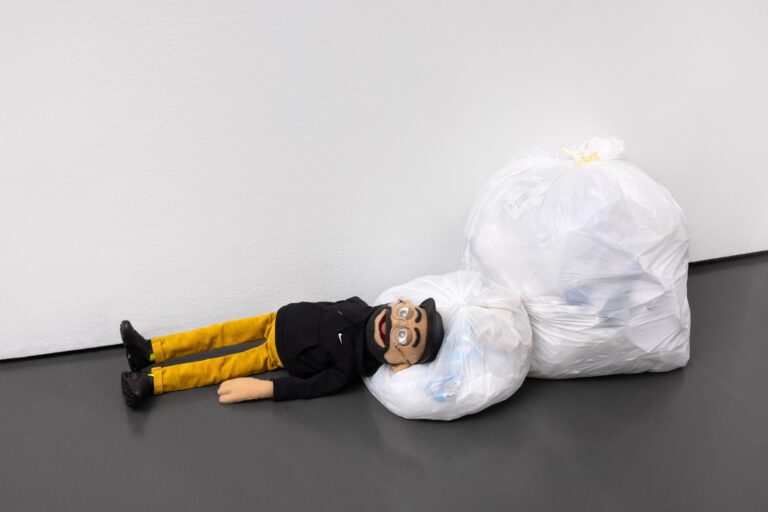
Ryan Gander
Swan Song (They will only encourage you to perform the script), 2024
Animatronic puppet, plastic
20 x 53 x 27 cm (7 7/8 x 20 7/8 x 10 5/8 in) (puppet)
40 x 105 x 34 cm (15 3/4 x 41 3/8 x 13 3/8 in) (overall)
Duration: 13:13 min
Exhibition view: Ryan Gander, THIS IS FEELING ALL OF IT, Esther Schipper, Berlin 2024
Courtesy the artist and Esther Schipper, Berlin/Paris/Seoul
Photo © Andrea Rossetti
© The artist / VG Bild-Kunst, Bonn 2024
THIS IS FEELING ALL OF IT draws on Gander’s research into human perception and cognition, investigating the variety of ways in which humans navigate and perceive the world around them. Particular focuses include his research into Autism, with his six-year old son Baxter having been diagnosed several years ago, alongside ongoing themes around attention and distraction — terms highly charged in cultural discussions of the last 150 years, and increasingly so in the context of social media and their impact on changing human cognition. Gander’s exhibition addresses these topics as artist and father, transforming them into artworks that are profoundly moving and thought-provoking, a subtle celebration of cognitive diversity. The exhibition also premiers Gander’s first artificial intelligence virtual reality artwork, co-commissioned and presented by global arts and technology initiative VIVE Arts in partnership with Esther Schipper and organised with Olivier Renaud-Clément.
The first work visitors encounter is a giant upended balloon blocking the entrance to the exhibition space. Bearing the question “Do ghosts have teeth?”, the work represents the inquisitiveness of children who ask what more jaded grown-up minds often dismiss as non-sensical or illogical. What is here the obstacle? The ball or our inability to engage with such feats of the imagination?
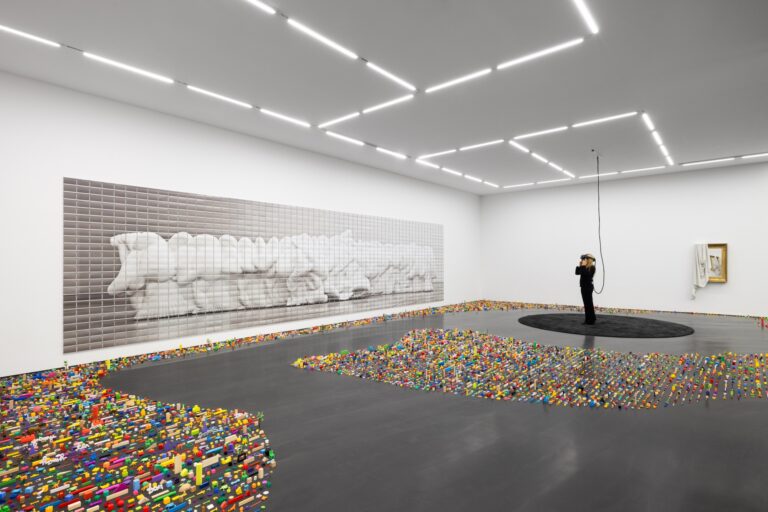
Exhibition view: Ryan Gander, THIS IS FEELING ALL OF IT, Esther Schipper, Berlin 2024
Courtesy the artist and Esther Schipper, Berlin/Paris/Seoul
Photo © Andrea Rossetti
© The artist / VG Bild-Kunst, Bonn 2024
Moving instead to the next entrance, visitors pass a machine that dispenses Gander’s unrealised ideas for artworks. Producing them at such speed that giving them away is preferable to feeling the burden of holding onto them, and realising that he can never execute all the ideas, Gander’s work is both an act of generosity and an acknowledgement of his own mortality.
Looking inside the exhibition space, a sea of tiny toys becomes apparent. Aligned in neat rows they only leave open narrow pathways just wide enough for a visitor to travel through. The work is both a collaboration with his son and a portrait of sorts, by means of the young boy‘s favourite activity of ordering these toys. For Gander, it is a celebration of his son‘s particular sense of beauty and order and the toys a representation of an emotional landscape. Navigating its paths is a symbol for the distinct ways we, and Baxter, are operating in the world.
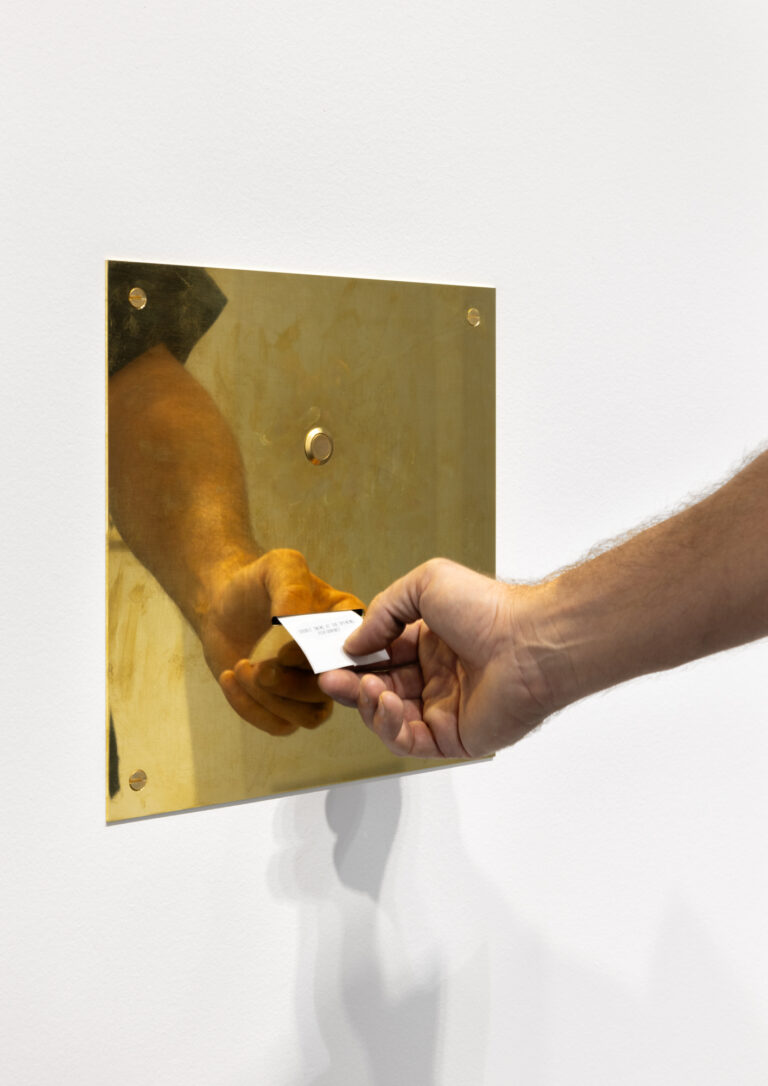
Ryan Gander
Idea machine, 2024
Steel, thermal receipt printer, motion sensor
30 x 30 x 27,5 cm
Exhibition view: Ryan Gander, THIS IS FEELING ALL OF IT, Esther Schipper, Berlin 2024
Courtesy the artist and Esther Schipper, Berlin/Paris/Seoul
Photo © Andrea Rossetti
© The artist / VG Bild-Kunst, Bonn 2024
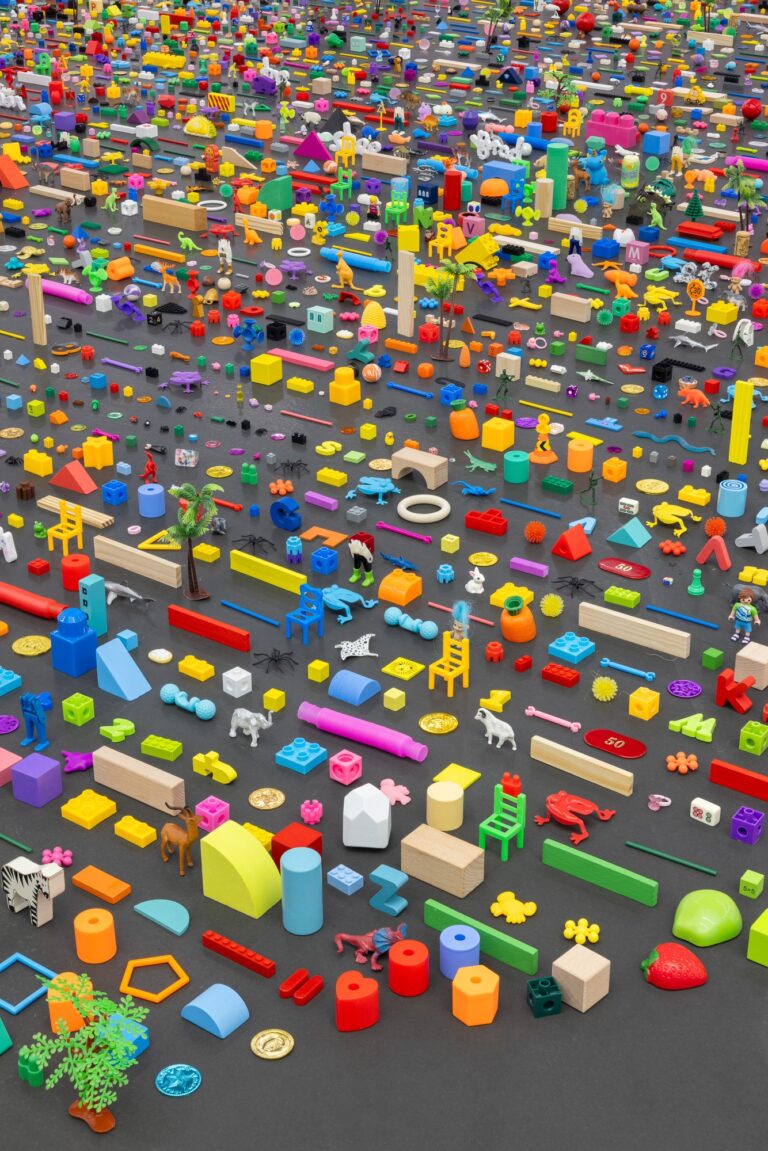
Ryan Gander
Closed systems, 2024
Floor installation, wooden and plastic toys
Dimensions variable
Exhibition view: Ryan Gander, THIS IS FEELING ALL OF IT, Esther Schipper, Berlin 2024
Courtesy the artist and Esther Schipper, Berlin/Paris/Seoul
Photo © Andrea Rossetti
© The artist / VG Bild-Kunst, Bonn 2024
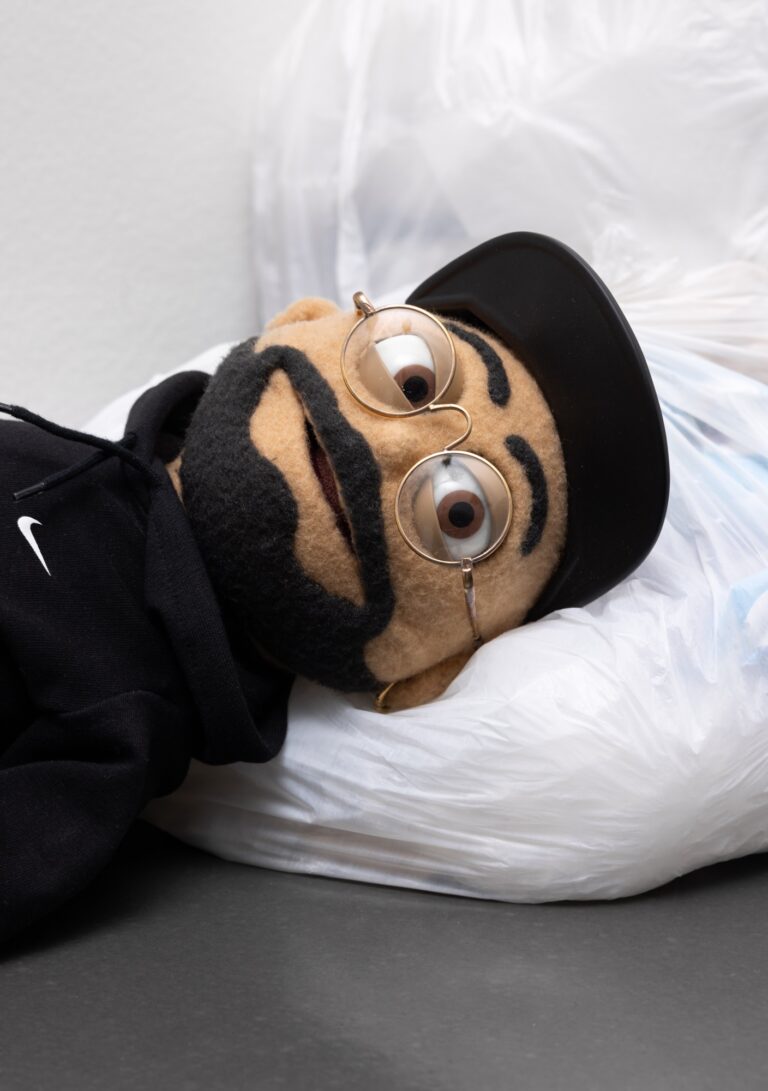
Ryan Gander
Swan Song (They will only encourage you to perform the script), 2024
Animatronic puppet, plastic
20 x 53 x 27 cm (7 7/8 x 20 7/8 x 10 5/8 in) (puppet)
40 x 105 x 34 cm (15 3/4 x 41 3/8 x 13 3/8 in) (overall)
Duration: 13:13 min
Exhibition view: Ryan Gander, THIS IS FEELING ALL OF IT, Esther Schipper, Berlin 2024
Courtesy the artist and Esther Schipper, Berlin/Paris/Seoul
Photo © Andrea Rossetti
© The artist / VG Bild-Kunst, Bonn 2024
Next to the entrance a small-scale doll version of Ryan Gander appears to be resting on a garbage bag. Moving his head from one side to the other, his chest rising with regular breaths, the toy-like representation of the artist also speaks. The doll represents a fictional alter ego, an artist who has not been successful, who is obsessed with attention, overly narcissistic and generally disinterested in contributing to human culture. At the same time, one senses, the „little stink“ as Gander calls him, is also stand-in for the artist‘s fears: is the real Ryan really better than that? Has he transcended his dread of becoming like him?
Baxter is also the subject of a new major work that covers almost one entire wall. A postcard rack holds over 1500 cards in a grid that together create an image, the rendering of an unexecuted marble sculpture of his son. The portrait is durational: the sculpture is based on a 20 second scan of Baxter. Having created several sculptures with his elder daughters, Gander sought to portray his son true to his being, in near constant movement, a coping strategy which is part of a self-stimulating behaviour called stimming, that can alleviate an overflow of cognitive information.
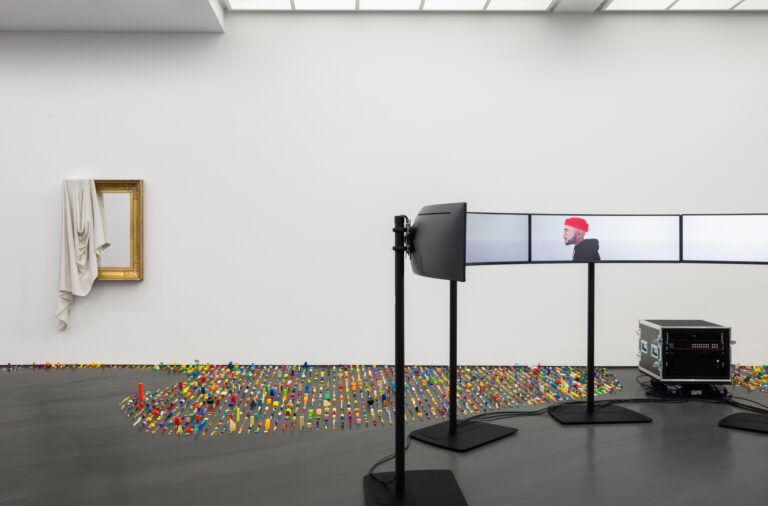
Exhibition view: Ryan Gander, THIS IS FEELING ALL OF IT, Esther Schipper, Berlin 2024
Courtesy the artist and Esther Schipper, Berlin/Paris/Seoul
Photo © Andrea Rossetti
© The artist / VG Bild-Kunst, Bonn 2024
Exhibited as both an individual VR headset experience and a wrap-around environment of monitors for visitors to walk into, Ryan Waiting features an avatar of the artist waiting in an empty, perimeter-less landscape, showcasing an uncanny life-likeness due to motion capture which retains characteristic gestures and body language. Acting as a durational hundred-year performance and taking two years to develop, the avatar’s actions are continually self-written in real-time whether there is a spectator watching or not; affected by time of day and external data gathered from the internet, the avatar’s mood is in constant in flux and will ultimately outlive us all. The focus of Gander’s work is not just on longevity but it also addresses the spectacularisation of everyday life. The experience highlights the state of being in-between—waiting—even deliberately ignoring any supposed audience. Gander’s work shifts the emphasis onto a rare commodity in today‘s life—doing nothing, waiting, enjoying boredom, ennui—traditionally the state of inspiration, creativity, and sudden ideas. But, what is Ryan waiting for? Clearly not us, as the avatar seems to deliberately avoid us.
A work, Couvrir, may be a portrait the artist made with his son. But, just as we can never experience the entirety of Ryan Waiting, this paintings also remains partially hidden, its contents forever shielded from view. Two mirrors in antique gilded frames are also partially obscured. Draped with heavy white cloth—actually consisting of marble—their mirrored surfaces are permanently veiled, impeding the spectators’ desire to see their own reflections.
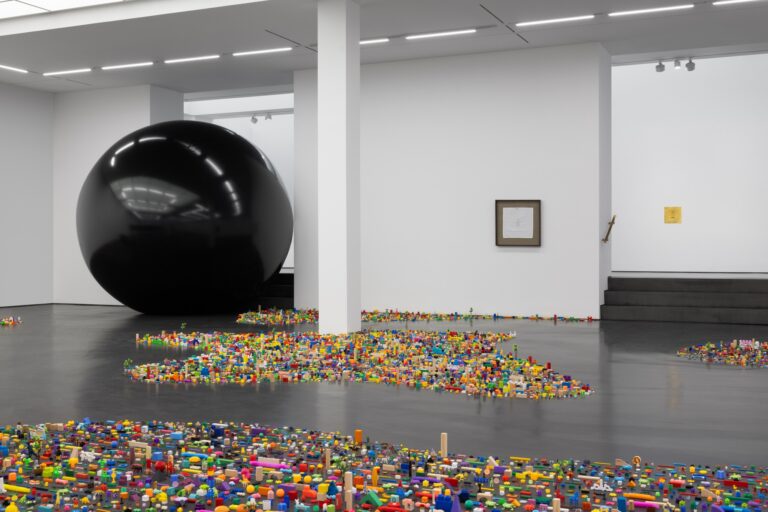
Exhibition view: Ryan Gander, THIS IS FEELING ALL OF IT, Esther Schipper, Berlin 2024
Courtesy the artist and Esther Schipper, Berlin/Paris/Seoul
Photo © Andrea Rossetti
© The artist / VG Bild-Kunst, Bonn 2024
The title, THIS IS FEELING ALL OF IT is both a reference to the artist’s earlier exhibition entitled This Feeling is Everything, and as such acknowledging the passage of time, and a description of Autism’s central feature: an unfilterable onslaught of all sensorial stimuli.
Ryan Gander was born in 1976 in Chester, England. He received his First Class Degree, BA (Hons) in Interactive Art at Manchester Metropolitan University and was a Post-Graduate Fine Art Participant at Jan van Eyck Academie Maastricht and Rijksakademie van Beeldende Kunsten in Amsterdam. The artist lives and works between Suffolk and London. Gander has been invited to teach and lecture at numerous institutions, such as the AA School of Architecture, London; Barbican, London; Barnard College, New York, and École nationale supérieure des Beaux-Arts, Lyon. Gander has been awarded numerous prizes including: the 2010 Zurich Art Prize, the 2006 ABN Amro Art Prize, and the 2003 Dutch Prix de Rome for Sculpture. In 2015, he received the honorary degree Doctor of Arts of the Manchester Metropolitan University. In 2017 he was awarded an OBE (Order of British Empire) for services to contemporary art. In 2022 he was elected as Royal Academician.
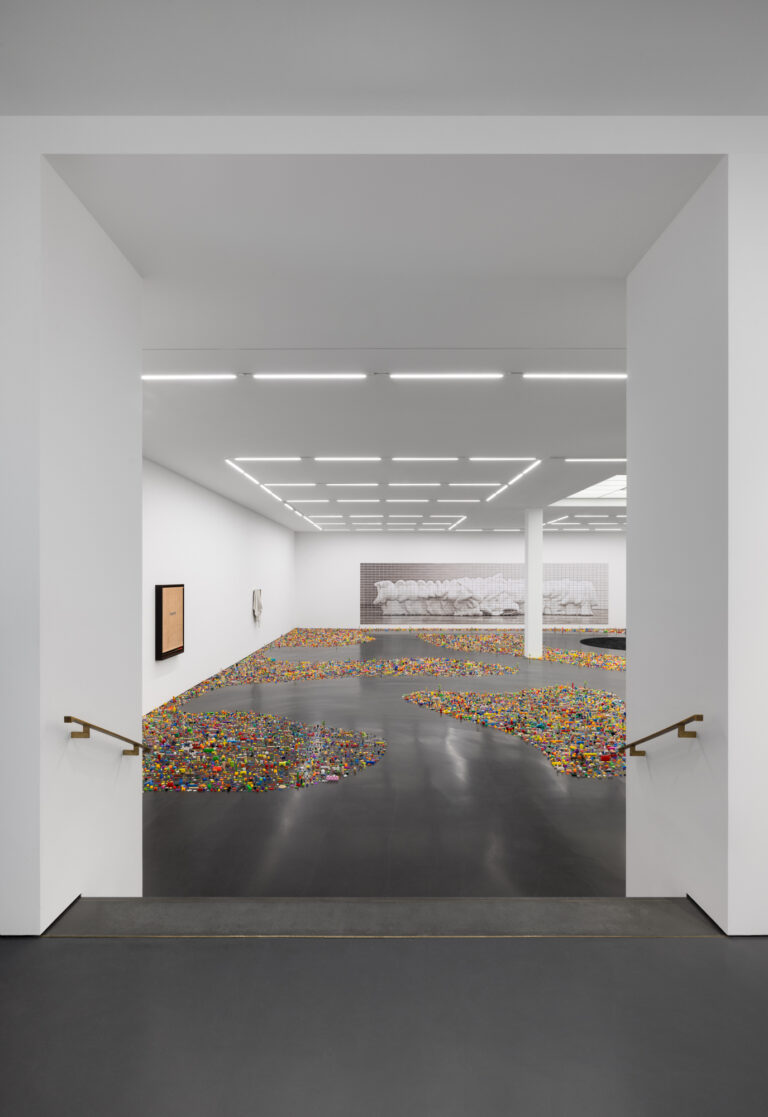
Exhibition view: Ryan Gander, THIS IS FEELING ALL OF IT, Esther Schipper, Berlin 2024
Courtesy the artist and Esther Schipper, Berlin/Paris/Seoul
Photo © Andrea Rossetti
© The artist / VG Bild-Kunst, Bonn 2024
The artist has had numerous solo exhibitions, among them: Grunts, hoots, whimpers, barks and screams, Museum of Contemporary Art Helga de Alvear, Cáceres, SP (upcoming); I’m just resting my eyes, Ishikawa Cultural Foundation, Okayama (2023); The Markers of our Time, Tokyo Opera City Gallery, Tokyo (2022); and The 500 Million Year Collaboration, Kunsthalle Bern (2019).
For press inquires please contact David Ulrichs at david@davidulrichs.com or +49 (0)176 5033 0135.
